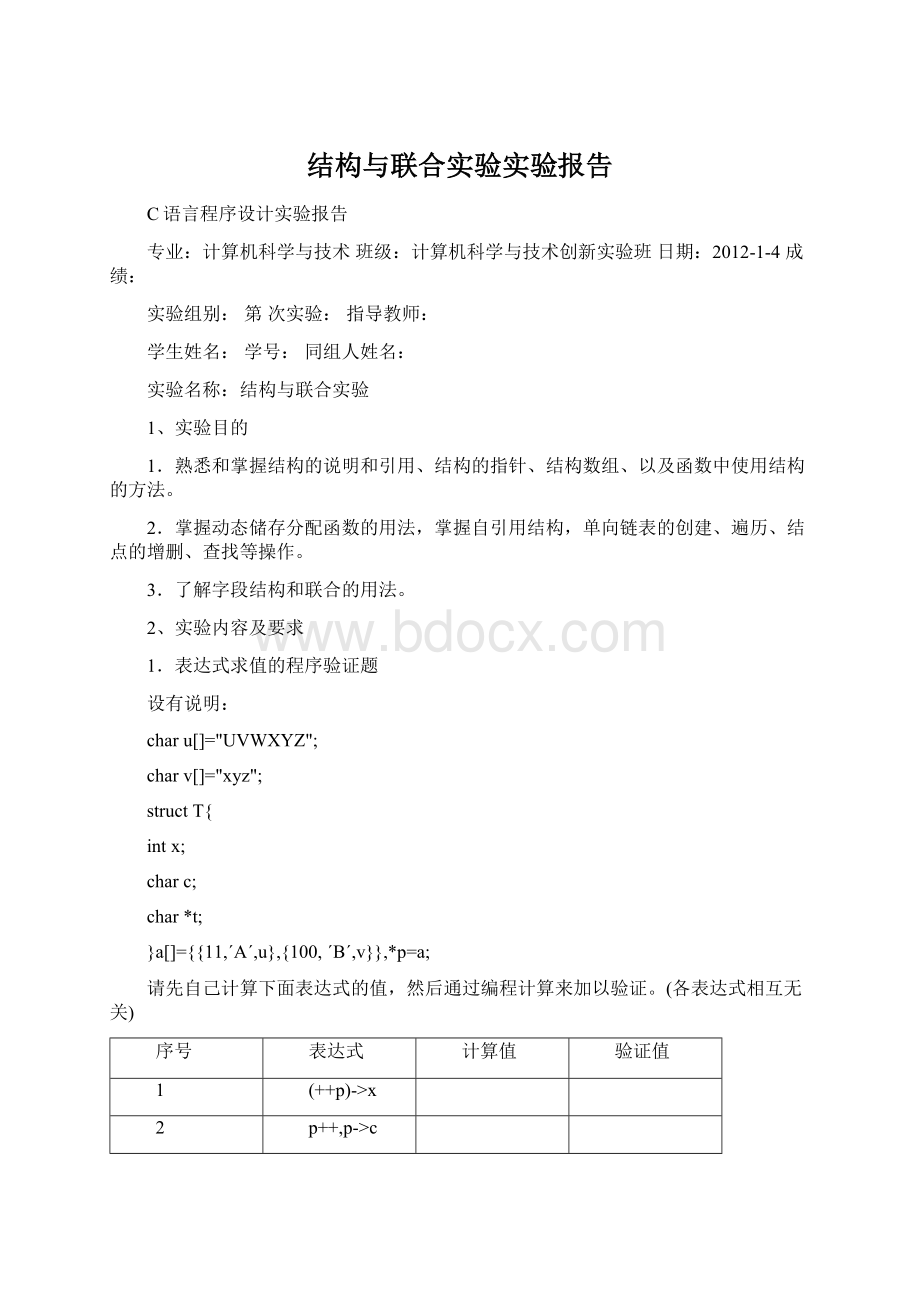结构与联合实验实验报告.docx
《结构与联合实验实验报告.docx》由会员分享,可在线阅读,更多相关《结构与联合实验实验报告.docx(41页珍藏版)》请在冰豆网上搜索。

结构与联合实验实验报告
C语言程序设计实验报告
专业:
计算机科学与技术班级:
计算机科学与技术创新实验班日期:
2012-1-4成绩:
实验组别:
第次实验:
指导教师:
学生姓名:
学号:
同组人姓名:
实验名称:
结构与联合实验
1、实验目的
1.熟悉和掌握结构的说明和引用、结构的指针、结构数组、以及函数中使用结构的方法。
2.掌握动态储存分配函数的用法,掌握自引用结构,单向链表的创建、遍历、结点的增删、查找等操作。
3.了解字段结构和联合的用法。
2、实验内容及要求
1.表达式求值的程序验证题
设有说明:
charu[]="UVWXYZ";
charv[]="xyz";
structT{
intx;
charc;
char*t;
}a[]={{11,ˊAˊ,u},{100,ˊBˊ,v}},*p=a;
请先自己计算下面表达式的值,然后通过编程计算来加以验证。
(各表达式相互无关)
序号
表达式
计算值
验证值
1
(++p)->x
2
p++,p->c
3
*p++->t,*p->t
4
*(++p)->t
5
*++p->t
6
++*p->t
2.源程序修改、替换
下面所给源程序的功能是:
给定一批整数,以0作为结束标志且不作为结点,将其建成一个先进先出的链表,先进先出链表的指头指针始终指向最先创建的结点(链头),先建结点指向后建结点,后建结点始终是尾结点。
请完成以下工作:
(1)源程序中存在什么样的错误(先观察执行结果)?
对程序进行修改、调试,使之能够正确完成指定任务。
(2)修改替换create_list函数,将其建成一个后进先出的链表。
后进先出链表的头指针始终指向最后创建的结点(链头),后建结点指向先建结点,先建结点始终是尾结点。
源程序:
#include"stdio.h"
#include"stdlib.h"
structs_list{
intdata;/*数据域*/
structs_list*next;/*指针域*/
};
voidcreate_list(structs_list*headp,int*p);
voidmain(void)
{
structs_list*head=NULL,*p;
ints[]={1,2,3,4,5,6,7,8,0};/*0为结束标记*/
create_list(head,s);/*创建新链表*/
p=head;/*遍历指针p指向链头*/
while(p){
printf("%d\t",p->data);/*输出数据域的值*/
p=p->next;/*遍历指针p指向下一结点*/
}
printf("\n");
}
voidcreate_list(structs_list*headp,int*p)
{
structs_list*loc_head=NULL,*tail;
if(p[0]==0)/*相当于*p==0*/
;
else{/*loc_head指向动态分配的第一个结点*/
loc_head=(structs_list*)malloc(sizeof(structs_list));
loc_head->data=*p++;/*对数据域赋值*/
tail=loc_head;/*tail指向第一个结点*/
while(*p){/*tail所指结点的指针域指向动态创建的结点*/
tail->next=(structs_list*)malloc(sizeof(structs_list));
tail=tail->next;/*tail指向新创建的结点*/
tail->data=*p++;/*向新创建的结点的数据域赋值*/
}
tail->next=NULL;/*对指针域赋NULL值*/
}
headp=loc_head;/*使头指针headp指向新创建的链表*/
}
3.程序设计
编写并上机调试运行能实现以下功能的程序或函数:
(1)编写一个程序,实现以下功能:
设计一个字段结构structbits,它将一个8位无符号字节从最低位向最高位声明为8个字段,各字段依次为bit0,bit1,…,bit7,且bit0的优先级最高。
同时设计8个函数,第i个函数以biti(i=0,1,2,…,7)为参数,并且在函数体内输出biti的值。
将8个函数的名字存入一个函数指针数组p_fun。
如果bit0为1,调用p_fun[0]指向的函数。
如果structbits中有多位为1,则根据优先级从高到低依次调用函数指针数组p_fun中相应元素指向的函数。
8个函数中的第0个函数可以设计为:
voidf0(structbitsb)
{
Printf(“thefunction%discalled!
\n”,b);
}
(2)假设用单向链表建立一张班级成绩单,包括每个学生的学号、姓名、英语、高等数学、普通物理、C语言程序设计四门课程的成绩。
用函数编程实现下列功能:
(1)输入每个学生的各项信息。
(2)输出每个学生的各项信息。
(3)修改指定学生的指定数据项的内容。
(4)统计每个同学的平均成绩(保留2位小数)。
(5)输出各位同学的学号、姓名、四门课程的总成绩和平均成绩。
4.选做题
(1)对上述程序设计题中第
(2)题的程序,增加按照平均成绩进行升序排序的函数,试写出用交换节点数据域的方法升序排序的函数,排序可选择用选择法或冒泡法。
(2)对选做题第
(1)题,进一步写出用交换1节点指针域的方法升序排序的函数。
(3)采用双向链表重做编程设计题中的第
(2)题。
三、实验步骤及结果
1.表达式求值的程序验证
序号
表达式
计算值
验证值
1
(++p)->x
100
100
2
p++,p->c
B
B
3
*p++->t,*p->t
x
x
4
*(++p)->t
x
x
5
*++p->t
V
V
6
++*p->t
V
V
验证程序:
#include
intmain(void)
{
char*m;char*n;char*e;char*f;
charu[]="UVWXYZ";
charv[]="xyz";
m=u,n=v;
structT{
intx;
charc;
char*t;
}a[]={{11,'A',u},{100,'B',v}},*p=a;
e=a[0].t;f=a[1].t;
printf("1.(++p)->x\t%d\n",(++p)->x);
p=a;*u=*m;*v=*n;a[0].t=e;a[1].t=f;
printf("2.p++,p->c\t%c\n",(p++,p->c));
p=a;*u=*m;*v=*n;a[0].t=e;a[1].t=f;
printf("3.*p++->t,*p->t\t%c\n",(*p++->t,*p->t));
p=a;*u=*m;*v=*n;a[0].t=e;a[1].t=f;
printf("4.*(++p)->t\t%c\n",(*(++p)->t));
p=a;*u=*m;*v=*n;a[0].t=e;a[1].t=f;
printf("5.*++p->t\t%c\n",(*++p->t));
p=a;*u=*m;*v=*n;a[0].t=e;a[1].t=f;
printf("6.++*p->t\t%c\n",(++*p->t));
return0;
}
2.源程序修改、替换
(1)
#include
#include
structs_list{
intdata;
structs_list*next;
};
voidcreat_list(structs_list**headp,int*p);
intmain()
{
structs_list*head=NULL,*p;
ints[]={1,2,3.4,5,6,7,8,0};
creat_list(&head,s);
p=head;
while(p){
printf("%d\t",p->data);
p=p->next;
}
printf("\n");
return0;
}
voidcreat_list(structs_list**headp,int*p)
{
structs_list*loc_head=NULL,*tail;
if(p[0]==0)
;
else
{
loc_head=(structs_list*)malloc(sizeof(structs_list));
loc_head->data=*p++;
tail=loc_head;
while(*p)
{
tail->next=(structs_list*)malloc(sizeof(structs_list));
tail=tail->next;
tail->data=*p++;
}
tail->next=NULL;
}
*headp=loc_head;
}
(2)
#include
#include
structs_list{
intdata;
structs_list*next;
};
voidcreat_list(structs_list**headp,int*p);
intmain()
{
structs_list*head=NULL,*p;
ints[]={1,2,3.4,5,6,7,8,0};
creat_list(&head,s);
p=head;
while(p){
printf("%d\t",p->data);
p=p->next;
}
printf("\n");
return0;
}
voidcreat_list(structs_list**headp,int*p)
{
structs_list*loc_head=NULL,*tail;
if(p[0]==0)
;
else
{
loc_head=(structs_list*)malloc(sizeof(structs_list));
tail=loc_head;
loc_head->data=*p++;
while(*p)
{
loc_head=(structs_list*)malloc(sizeof(structs_list));
loc_head->data=*p++;
loc_head->next=tail;
tail=loc_head;
}
}
*headp=loc_head;
}
3.程序设计
(1)
#include
structbits{
unsignedcharbit0:
1;
unsignedcharbit1:
1;
unsignedcharbit2:
1;
unsignedcharbit3:
1;
unsignedcharbit4:
1;
unsignedcharbit5:
1;
unsignedcharbit6:
1;
unsignedcharbit7:
1;
}t;
voidf0(structbitsb)
{
printf("the1function%discalled!
\n",b.bit0);
}
voidf1(structbitsb)
{
printf("the2function%discalled!
\n",b.bit1);
}
voidf2(structbitsb)
{
printf("the3function%discalled!
\n",b.bit2);
}
voidf3(structbitsb)
{
printf("the4function%discalled!
\n",b.bit3);
}
voidf4(structbitsb)
{
printf("the5function%discalled!
\n",b.bit4);
}
voidf5(structbitsb)
{
printf("the6function%discalled!
\n",b.bit5);
}
voidf6(structbitsb)
{
printf("the7function%discalled!
\n",b.bit6);
}
voidf7(structbitsb)
{
printf("the8function%discalled!
\n",b.bit7);
}
intmain(void)
{
printf("pleaseinputanunsignedbit:
\n");
unionw{
unsignedcharh;
structbitst;
}a;
a.h=getchar();
void(*p_fun[8])(structbits);
p_fun[0]=f0;
p_fun[1]=f1;
p_fun[2]=f2;
p_fun[3]=f3;
p_fun[4]=f4;
p_fun[5]=f5;
p_fun[6]=f6;
p_fun[7]=f7;
if(a.t.bit0)p_fun[0](a.t);
if(a.t.bit1)p_fun[1](a.t);
if(a.t.bit2)p_fun[2](a.t);
if(a.t.bit3)p_fun[3](a.t);
if(a.t.bit4)p_fun[4](a.t);
if(a.t.bit5)p_fun[5](a.t);
if(a.t.bit6)p_fun[6](a.t);
if(a.t.bit7)p_fun[7](a.t);
return0;
}
(2)
#include
#include
#include
structstu
{
longnum;
chars[10];
intc1;
intc2;
intc3;
intc4;
structstu*next;
};
voidcreatlist(structstu**headp);
voidoutputlist(structstu**headp);
voidcorrectlist(structstu**headp);
voidavstu(structstu**headp);
voidsumstu(structstu**headp);
intmain()
{
structstu*head=NULL;
creatlist(&head);
outputlist(&head);
correctlist(&head);
avstu(&head);
sumstu(&head);
return0;
}
voidcreatlist(structstu**headp)
{
*headp=(structstu*)malloc(sizeof(structstu));
structstu*tail=*headp,*p=*headp;
printf("pleaseinputthenumberofstudentthenameGradeofEnglishGradeofmathGradeofphysicsGradeofClanguage.\n");
printf("Toendtheinput,pleaseintput0asthenumberofstudent.\n");
for(;;)
{
scanf("%ld",&p->num);
if(p->num==0)
break;
scanf("%s%d%d%d%d",p->s,&p->c1,&p->c2,&p->c3,&p->c4);
p=(structstu*)malloc(sizeof(structstu));
tail->next=p;
tail=p;
}
tail->next=NULL;
}
voidoutputlist(structstu**headp)
{
structstu*p=*headp;
while(p->next!
=NULL)
{
printf("ID%ldNAME%sENG%dMATH%dPHY%dC%d\n",p->num,p->s,p->c1,p->c2,p->c3,p->c4);
p=p->next;
}
}
voidcorrectlist(structstu**headp)
{
charc;
structstu*p;
p=*headp;
printf("1:
lookupbyname\n");
printf("2:
lookupbynumber\n");
c=getchar();
c=getchar();
switch(c)
{
case'1':
printf("pleaseinputthename\n");
chart[10];
scanf("%s",t);
for(;p->next!
=NULL&&strcmp(p->s,t);p=p->next)
;
if(!
strcmp(p->s,t))
printf("FINDID%ldNAME%sENG%dMATH%dPHY%dC%d\n",p->num,p->s,p->c1,p->c2,p->c3,p->c4);
elseif(p->next==NULL)
{
printf("NOTFOUND\n");
return;
}
break;
case'2':
printf("pleaseinputthenumber\n");
longtmp;
scanf("%ld",&tmp);
for(;p->next!
=NULL&&tmp!
=p->num;p=p->next)
;
if(tmp==p->num)
printf("FINDID%ldNAME%sENG%dMATH%dPHY%dC%d\n",p->num,p->s,p->c1,p->c2,p->c3,p->c4);
elseif(p->next==NULL)
{
printf("NOTFOUND\n");
return;
}
break;
}
printf("whichonetochange?
\n");
printf("1:
number\n");
printf("2:
name\n");
printf("3:
GradeofEnglish\n");
printf("4:
GradeofMath\n");
printf("5:
GradeofPhysics\n");
printf("6:
GradeofCLanguage\n");
printf("7:
Idon'twanttochageanything\n");
c=getchar();
c=getchar();
printf("pleasereinput\n");
switch(c)
{
case'1':
scanf("%ld",&p->num);
break;
case'2':
scanf("%s",p->s);
break;
case'3':
scanf("%d",&p->c1);
break;
case'4':
scanf("%d",&p->c2);
break;
case'5':
scanf("%d",&p->c3);
break;
case'6':
scanf("%d",&p->c4);
default:
return;
}
}
voidavstu(structstu**headp)
{
structstu*p=*headp;
for(;p->next!
=NULL;p=p->next)
{
doubletp;
tp=(p->c1+p->c2+p->c3+p->c4)/4.0;
printf("ID%ldName%saverage%.2lf\n",p->num,p->s,tp);
}
}
voidsumstu(structstu**headp)
{
structstu*p;
p=*headp;
for(;p->next!
=NULL;p=p->next)
{
doubletp;
intsum;
sum=p->c1+p->c2+p->c3+p->c4;
tp=sum/4.0;
printf("ID%ldName%ssumis%daverageis%.2lf\n",p->num,p->s,sum,tp);
}
}
4.选做题
(1)
#include
#include
#include
structstu
{
longnum;
chars[10];
intc1;
intc2;
intc3;
intc4;
doublec5;
structstu*next;
};
voidcreatlist(structstu**headp);
voidoutputlist(structstu**headp);
voidcorrectlist(structstu**headp);
voidavstu(structstu**headp);
voidsumstu(structstu**headp);
voidsort_lists(structstu*head);
voidoutputlist2(structstu**headp);
int